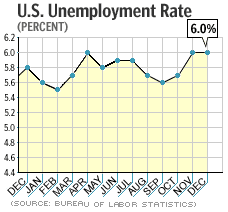NEW YORK (CNN/Money) -
New weekly claims for jobless benefits in the United States edged down a bit last week, the government said Thursday, as the labor market struggled to recover from heavy job cuts in 2001 and 2002.
The Labor Department said the number of Americans filing new claims for unemployment benefits fell to 391,000 in the week ended Feb. 1 from a revised 402,000 the prior week. Economists, on average, expected 390,000 new claims, according to Briefing.com.
Separately, the Labor Department said non-farm productivity fell at a 0.2 percent annual rate in the fourth quarter of 2002 after rising at a revised 5.5 percent pace in the third quarter. Economists, on average, expected productivity growth of 0.7 percent, according to Briefing.com.

The reports had little impact on U.S. stock market futures, which fell, pointing to a negative opening on Wall Street. Treasury bond prices rose.
Economists consider any number of weekly jobless claims at or above 400,000 to be an indication of labor market weakness.
The four-week moving average of claims, which irons out the fluctuations in the often-volatile weekly data, dropped to 384,750 in the latest week from a revised 385,250 the prior week.
The number of continued claims, or people drawing benefits for more than a week, rose to 3.53 million in the week ended Jan. 25, the latest data available, from a revised 3.29 million the prior week.
The report comes a day before the Labor Department's report on unemployment and payroll growth in January. Economists, on average, expect unemployment to stay at 6 percent and non-farm payrolls to grow by about 69,000 jobs, according to Briefing.com, following December's 101,000 job losses.
While it seems strange that jobs could grow without moving the unemployment rate down, the numbers come from two separate surveys, and most economists think such job growth is too weak to make much of a difference in the labor market anyway.
The labor market has been suffering for a long time, with employers cutting nearly 2 million jobs in 2001 and 2002.
Even though a recession that began in March 2001 likely ended late in 2001, concerns about a possible war in Iraq, uncertainty about the strength of the economy, sluggish profit growth and an excess of production capacity have kept businesses from spending money and hiring new workers.
And companies have found they can squeeze more work out of fewer workers, helping support corporate profits during the downturn and raising hopes for a healthier economy in the future, but offering little incentive right now for businesses to hire.

|

